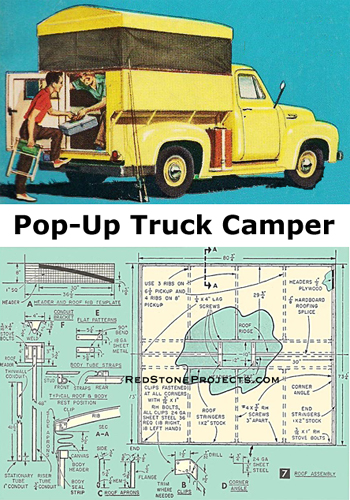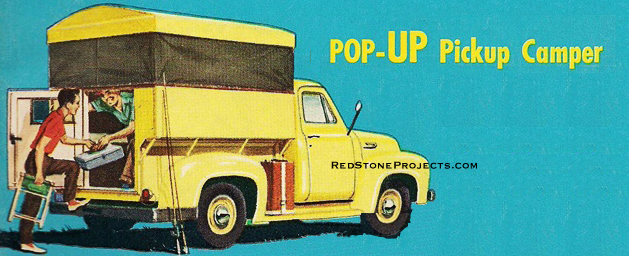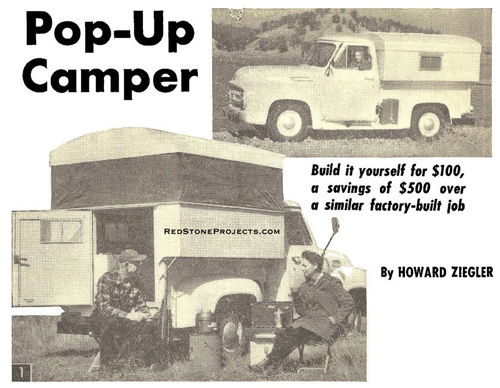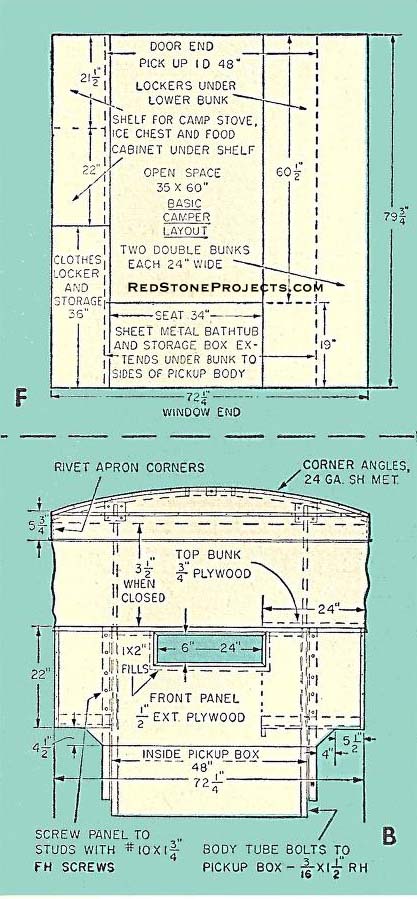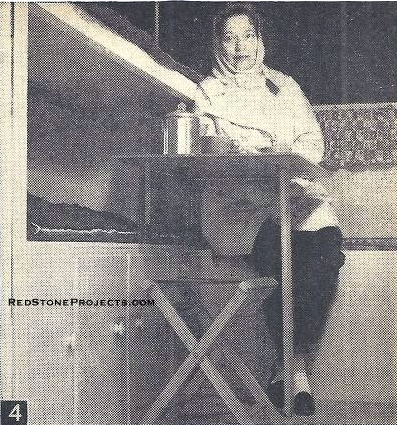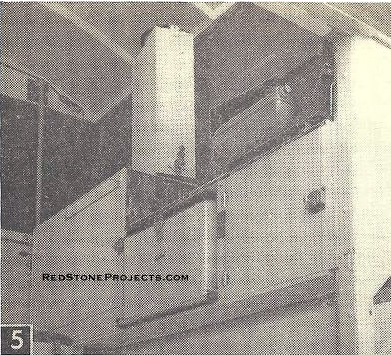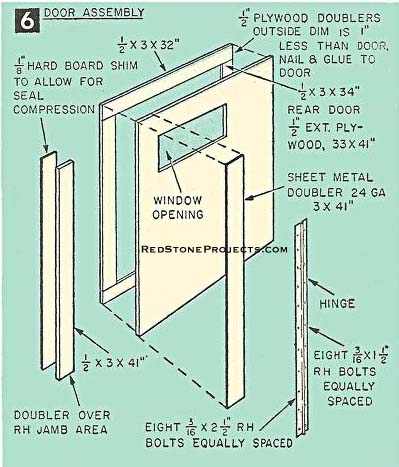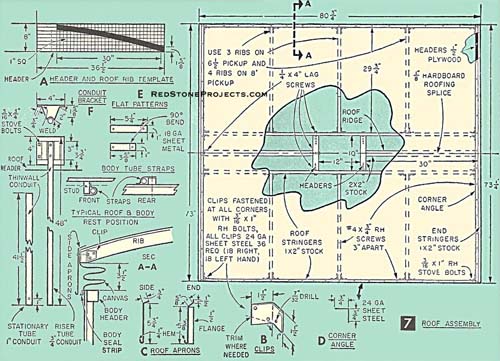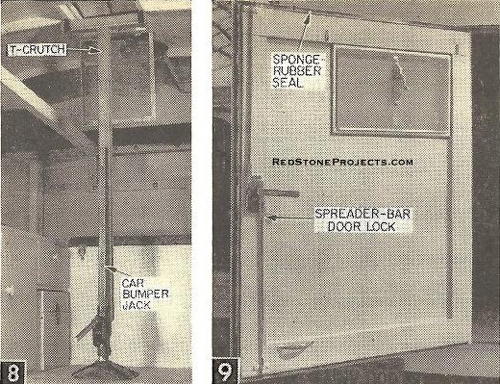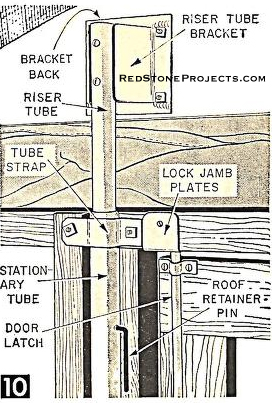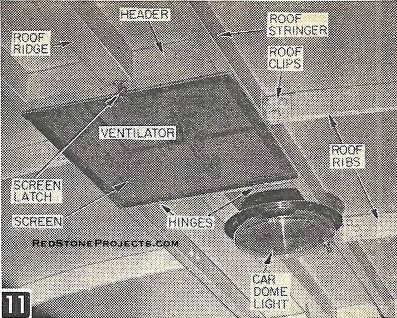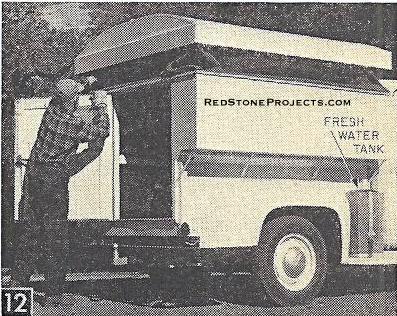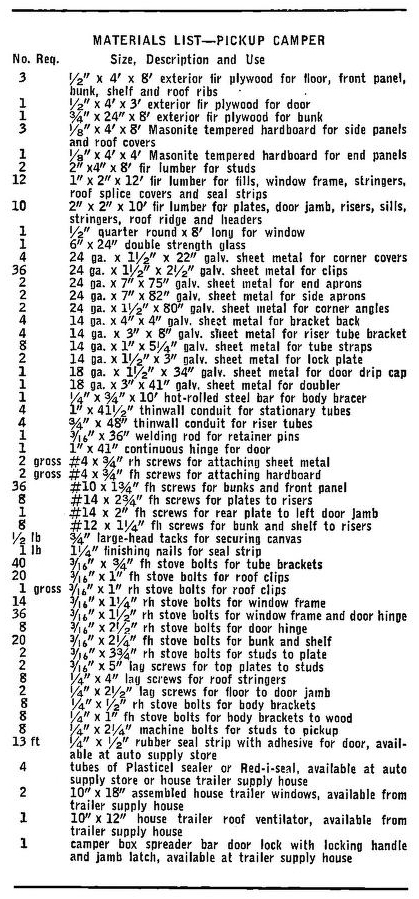 |
|||||||||||||||||||||||||||||||||||||||||||||||||||||||||||||||||||||||||||||||||||||||||||||||||||||||||||||||||||||||||||||||||||||||||||||
|
All Orders Processed on a Secure Server Build a Pickup Truck Pop Up Camper Truck Bed Mounted Pop Up Camper Plans
Start by checking the basic dimensions of the framework (Fig. 2). Note that the whole structure is built around four studs (Fig. 2A) which fit in the pickup body post sockets. First, make the studs from 2 x 4-in. stock (actually 1 5/8 x 3 5/8 in.), notching the lower 12 in. to fit the body socket and to place the face of the stud flush with the outside surface of the truck body ends. The lower ends of the studs should make a snug fit in the sockets. Don't make them so tight that you have to drive them in. Notch the upper ends of the studs to receive the 1 5/8 x 1 5/8-in. plates. Next cut the front panel to size as in Fig. 2C. Location of the window opening will depend on location of the window in the pickup cab, so don't cut the opening until the panel has been temporarily clamped on the studs. Use a level to get the studs plumb and mark the stud locations on the panel. Then remove the panel and studs from the body and fasten panel to studs with #10 1 3/4-in. fh screws spaced 4 in. apart. Saw the window opening before you return the panel to the pickup. Make the window frame as in Fig. 2D and bolt it to the front panel. If the height of the window in your cab won't permit use of the upper window frame member, let the upper plate act as the top window frame member. Be sure to wrap the edges of the glass with friction tape before installing and use a generous seam of caulking between the glass and the retaining moldings (Sec. A-A in Fig. 2D). If you prefer, you can hold off on window installations until the whole job is done. This might save some broken glass. If you plan to cover the truck floor with 1/2-in. plywood, this should be installed now. Since pickup floors vary, you'll have to choose a type of fastener for the job. If the pickup floor has wooden slides, you can use flat head wood screws. Otherwise, you'll probably have to bolt it down. Install the two rear studs in the body sockets and notch
the tops of them for the plate as you did the front studs. Notice that
both the front and rear plates (Fig. 2E) are notched at each end to half-lap
with the side plates. The rear plate is also dadoed to receive the left-hand
door jamb. When installing the door jambs, fasten the left hand one with
the top screw and bottom lag screw, and the right hand one directly to
the stud. If necessary, use a shim between right jamb and stud when fastening
them together above the truck box.
At this point you have enough of the parts installed to provide a means of checking following parts for fit. Cut and fit the side plates next. Remember, these are notched at each end to form the half-lap joint with the front and rear plates. Cut corner and side risers to fit. Notch the bottom end of the side risers only to fit over the 1 x 2-in. fills that run along the outside edge of the lower bunk and shelf (Fig. 2). Then install the fills. Attach these to shelf and bunk with glue and nails driven up from the bottom. You can clamp these pieces in place while you nail them. Toe-nail where a fill meets a vertical member. Use glue and #14 x 2 3/4-in fh screws to secure plates to top ends of risers. Now you can install the 1/8-in. hardboard side panels. Set them up temporarily by tack nailing. Then drill and countersink for #4 x 3/4-in. fh screws, locating them 5 in apart. You can cover the left- and right-hand side at the rear now or leave it until later. In any event, panels are butted at the corners. The butt is covered with sealer and then a bead of sealer is put down on each flange of the corner covers. These sheet-metal covers (Fig. 2) can be bent over the edge of a workbench. Be sure, when you take up on the screws that hold them in place, that you have installed enough sealer so excess is squeezed out. The 3/4-in. plywood top bunk merely rests on the framework and is screwed to it and to the stiffener that runs along its inside edge. Now is a good time to make and install the body braces (Fig. 3D). Hacksaw these to length and bend in a vise. Heating the bend area with a blow torch will make the job easier. Best bet is to cut to length, make bend at one end, check on pick-up body, make second bend, then drill attachment holes. Use the bent-up braces (held in place) as template to drill holes through pickup body and underside of bottom bunk and shelf. Roof Assembly This is a separate assembly that you can fabricate on a bench or floor of the shop. Before you do anything else, be sure to measure and mark down the length and width dimensions of the camper body you have just built so you can make the roof assembly to fit your particular job. As we've designed it, inside clearance is 72 in. from the floor to the stringers. If you need more, just increase the vertical dimensions of the top headers and side stringers. Of course you will also have to compensate for other parts such as the side and end aprons. The central area of the roof is designed flat which makes the skylight installation a simple matter. Start by making full-size cardboard templates of the header and roof rib as in Fig. 7A. Use the cardboard templates to draw around when laying out the pieces on 1/2-in. plywood. One way to cut these ribs so all will be alike in shape and size is to nail the stock together one on top the other and cut them all simultaneously by stack-sawing on a band saw. If you want to economize on material, however, carefully lay out each rib close together on a single sheet of plywood and cut them out one at a time.
When assembling, start with the roof stringers, ridge and headers, attaching these to each other and to the end ribs. This will establish the flat area and also the curve which the ribs must meet. Assemble the ribs to the stringers with clips (Figs. 7
and 11, Sec. A-A). Make the clips as in Fig. 7B and fasten with 3/16 x
1-in. rh bolts. When installing the ribs, use a straight board placed across
the roof ends to assemble the top edges of the ribs flush with each other.
Details of the bracket parts and riser tubes are given in Fig. 7F, and the actual set-up is shown in Fig. 10. First cut the stationary tubes to length. These are not difficult to locate since they about the body studs; the straps which hold them in place can be shaped on the job. Cut the material as in Fig. 7E, secure one end to the stud (Fig. 10) and then bend the remainder to fit. Place the riser tubes in the stationary tubes and put the roof in place temporarily. Be sure the roof is accurately positioned and blocked up to be 3 1/2 in. above the body. Remember to allow for the thickness of the upper bunk on that side. Each of the riser tubes should be centered in the stationary tubes. You can do this with small pieces of wood acting as shims. The riser tube bracket parts can be made around a scrap piece of riser tube. The semi-circular seat for the riser tube can be made by slicing a short length of 1-in. tube in half lengthwise, and welding this to bent up sides. Again, it might be more convenient to have this part made for you, especially since welding is required. Clamp the bracket back in position and then place the riser tube bracket in place against the riser tube. Mark the location of the tube seat on the bracket back and have it welded accordingly. Follow this same procedure with each riser tube and bracket assembly. When this is done you can attach riser tubes to brackets and brackets to headers. Then remove the blocks which were holding the roof up. Lay out 4 3/4 in. from the top of the stationary tube and drill a 3/16 in. hole through both tube and stud. Do this on all four tubes. Use some scrap lumber to raise and support the roof until inside clearance is 6 ft. (or whatever height you require). Check distance from body top to roof in all four corners. All measurements should be equal. Now, using the holes already drilled in the stationary tube as a guide, drill through again to make the matching hole in the riser tube. These holes are for holding the roof in the raised position with the retainer pins (Fig. 10), which are 8 in. lengths of 3/16-in. welding rod bent at a right angle at the center.
Sew the canvas in the form of a large loop and when installing, be very careful to distribute excess evenly around the camper and allow for a vertical looseness of 1 1/2 in. (Fig. 3A and 7, Sec. A-A). This is what we did and after two years of use, the canvas is now just snug and no more. Tack the top of the canvas to the perimeter of the roof. Fasten the bottom of the canvas to the top of the body with the body seal strips as in Sec. A-A, Fig. 7. Tack the canvas down first, then attach strips with finishing nails. Remember to attach the door drip cap (Fig. 3E) over the door opening, before fastening down the canvas at this point. Now lower the roof to closed position. Set the aprons in position and check for clearance on all sides. Install the end aprons first. Apply sealer generously under all flanges and bend the ends around the corners so that the side aprons will cover the end aprons. Install the side aprons next. Fasten the corners of the aprons together with aluminum rivets. Next install the corner angles along the ends of the roof (Fig. 7D). This will be easier if you cut a slit at each screw hole to facilitate bending the angle to fit the contour of the roof. Start at the center and work out toward each edge. Make the Door Make the door as in Fig. 6. Be sure to check the size of the door opening on your camper body so the door will be a good fit. The sheet metal doubler at the hinge is a precaution against bolt pull-out. The hardboard shim under the jamb doubler will force the rubber to seal to half its original thickness and assures a weather-proof closure.
Knockdown Table and Bathtub Arrangement of storage cabinets, shelves and table can
be varied to suit your individual needs. We equipped ours with a little
knockdown table (Fig. 4) so we could eat indoors during rainy weather.
A fold-up card table would serve as well.
We fitted the area under the lower bunk with doors of 1/2-in. plywood as in Fig. 4 and use the space for storage. You may want to substitute one large lift-off door to cover this area so that long items such as fishing rods or rifles can be stored under the bunks. The clothes locker, food cabinet and shelf for the camp stove, located at the right side of the camper (Figs. 2F and 5), are made of 1/2-in. plywood joined at the corners with 1 x 2-in. cleats. We mounted the ice box on 1/2-in. plywood which is fastened to metal drawer slides of the type used for pull-out phono turntables.
|
